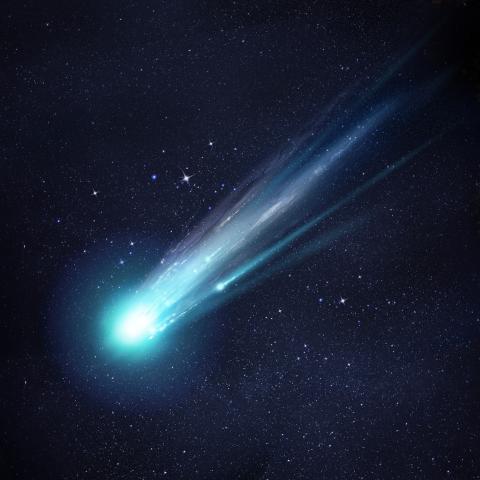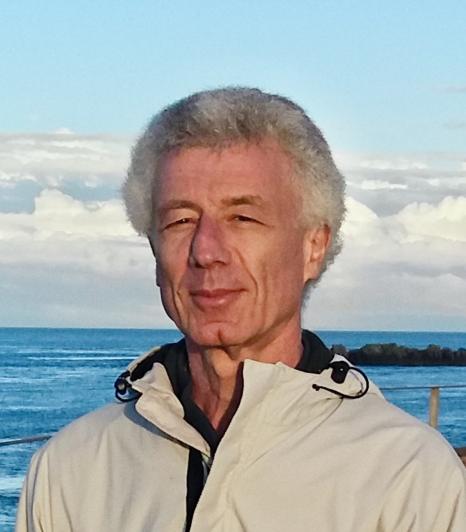
Alain Abergel: investigating the interstellar medium
Alain Abergel is a professor at Université Paris-Saclay and an astrophysicist at the Institute of Space Astrophysics (IAS - Univ. Paris-Saclay/French National Centre for Scientific Research, CNRS). A specialist in the interstellar medium, he has supported four decades of technological advances in space observation, from Halley's Comet to the first images from the James Webb telescope. An academic with a passion for physics and astrophysics, he has also made a major contribution to structuring the physics community at Université Paris-Saclay. Since 2021, he has been director of the Université Paris-Saclay Observatory of the Sciences of the Universe (OSUPS).
A scientific baccalaureate, a 2-year preparatory course for a competitive exam and then engineering school in Grenoble: at first glance, Alain Abergel's career path seems fairly conventional. However, he quickly realised that the courses he was most passionate about were those in fundamental physics at the university. Consequently, he decided to focus on a DEA (diploma of advanced studies, the equivalent of a 2nd year Master's degree in research today) in astrophysics at Université Pierre et Marie Curie (now Sorbonne University). His subsequent thesis put him at the centre of a major astronomical event: the passage of Halley's comet close to the Sun in 1986. "Working on the observations made with the cameras aboard the Soviet VEGA-1 and VEGA-2 spacecraft during the Halley flyby, I was one of the first to observe a cometary nucleus, its surface and its jets of gas and dust," he recalls.
A fascinating introduction that sealed his move into space astrophysics. After a post-doctorate, in 1989, he became a lecturer at the newly created Institute of Space Astrophysics (IAS) at Université Paris-Sud (now Université Paris-Saclay). He has remained at the university throughout his career, becoming a professor in 2002.
An infrared sky cameraman
Alain Abergel likes to describe himself as a "sky cameraman". Specialising in infrared astronomy, he analyses this radiation, invisible to the human eye but emitted by all objects due to their temperature. "Where the sky is black in visible light, the infrared range reveals a profusion of structures, especially when the sky appears darkened. These are molecular clouds where atoms meet on the smallest interstellar grains to form molecules, where grains of solid matter begin to assemble, the densest regions collapse gravitationally to give rise to stars surrounded by protoplanetary disks within which planets form."
Observing the interstellar medium is understanding the "beginning of the complexity" that leads to the emergence of life. "I'll always remember the presentation we made to the European Space Agency (ESA) of the first images of molecular clouds obtained with the camera of the European Infrared Space Observatory (ISO); the whole room applauded because, for the first time, we could see inside the clouds where stars are born. It was like looking at an X-ray of the human body for the first time," says the lecturer.
At the heart of major space missions
Alain Abergel's career has since continued in step with major space missions. After ISO was launched in 1995, he worked on the American Spitzer and COBE (Cosmic Background Explorer) missions, where his expertise in processing and exploiting long-wavelength space data was put to good use. In 2009, there were two new adventures with two ESA satellites, Herschel explored the sky in the far infrared, while Planck mapped the cosmic microwave background, providing unprecedented information on interstellar dust emission.
Today, the story continues with the James Webb Space Telescope. "From ISO and its 60 cm mirror to James Webb and its 6.6-metre mirror, from 32x32 pixel cameras to sensors of over 1000x1000 pixels: the technological contrast is staggering. Nowadays, we're not necessarily limited by the instruments, but our understanding of the physical processes at work in the Universe," he stresses.
A collective adventure
One of the reasons Alain Abergel has enjoyed his career so much is because he has always been part of a collective endeavour for these major space missions, which are the product of international consortia. Discussions with modellers, instrumentalists, chemists and physicists have been a constant. Similarly, he has worked with signal processing specialists, especially from the Laboratory of Signals and Systems (L2S - Univ. Paris-Saclay/CNRS/CentraleSupélec) "to produce the best possible data from space instruments".
Another more recent illustration of his commitment to build bridges is his involvement in the creation of the Innovative Common Laboratory for Space Spectroscopy (INCLASS) combining the expertise of the IAS and the company ACRI-ST. This is designed to share methods for exploiting space data for astrophysics and Earth observation.
Teaching as second nature
Although Alain Abergel had no teaching experience when he was recruited, at the university, he has discovered how teaching transforms the practice of research. "I've relearned all of physics, by broadening the range of subjects I taught throughout my career! Teaching challenges us, forces us to develop and be ever more thorough and open to new advances. It means presenting fundamental concepts within a framework that is accessible to students of all levels, without forgetting their societal interest," he explains.
He is involved at all levels of the university: head of first- and second-year fields of study, co-director of the 2nd year Master’s degree in astronomy and space tools and systems for ten years since its creation in 1999, lecturer in the magister degree in fundamental physics and deputy director of the Île-de-France astrophysics doctoral school from 2017 to 2021. His guiding principle is to support both students that are just starting out, "to help them get a foot on the ladder, motivate them for physics, give them good working methods and boost their self-confidence," and more advanced students, "with specialised courses and guidance right up to their professional integration".
A builder dedicated to physics at Université Paris-Saclay
In addition to his scientific and teaching activities, Alain Abergel has played a key role in structuring the physics community. As President of the physics Department at the Faculty of science (2011-2018), he helped to maintain the unity of a discipline with some 200 lecturers, and at least three times as many researchers.
During the creation of Université Paris-Saclay, he fought alongside his colleagues to prevent the physics community becoming fragmented. That effort led to the emergence of the Graduate School of physics, which is now enjoys major international visibility. "One of the great joys of my career is that I've been part of an absolutely exceptionally rich community of physicists at Université Paris-Saclay. It has given me so much, through the diversity of skills and exchanges, and I sincerely hope that it will continue to inspire generations of students, researchers and engineers."

